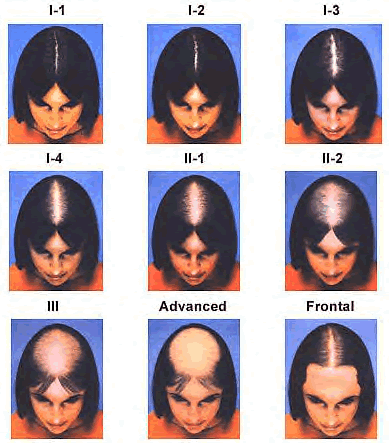Female Pattern Baldness
Unlike hair loss in men, female scalp hair loss may commonly begin at any age through 50 or later, and may not have any obvious hereditary association. A woman who notices the beginning of hair loss may not be sure if the loss is going to be temporary or permanent—for example, if there has been a recent event such as pregnancy or illness that may be associated with temporary hair thinning.
Self-diagnosis is often ineffective. Women tend to have less obvious patterns of hair loss than men, and non-pattern types of hair loss are more frequent in women than in men. Diagnosis of hair loss in a woman should be made by a trained and experienced physician.

Savin Scale for Female Hair Loss
In women as in men, the most likely cause of scalp hair loss is androgenetic alopecia—an inherited sensitivity to the effects of androgens (male hormones) on scalp hair follicles. However, women with hair loss due to this cause usually do not develop true baldness in the patterns that occur in men—female hair loss occurs in various patterns and is often diffuse or veiled vs bald. Patterns of female androgenetic alopecia can vary considerably in appearance.
Patterns That May Occur With Female Pattern Baldness Include:
- Diffuse thinning of hair over the entire scalp, often with more noticeable thinning toward the back of the scalp.
- Diffuse thinning over the entire scalp, with more noticeable thinning toward the front of the scalp but not involving the frontal hairline.
- Diffuse thinning over the entire scalp, with more noticeable thinning toward the front of the scalp, involving and sometimes breaching the frontal hairline.
Unlike the case for men, thinning scalp hair in women due to androgenetic alopecia does not uniformly grow smaller in diameter (miniaturize). Women with hair loss due to androgenetic alopecia tend to have miniaturizing hairs of variable diameter over all affected areas of the scalp. While miniaturizing hairs are a feature of androgenetic alopecia, miniaturization may also be associated with other causes and is not in itself a diagnostic feature of androgenetic alopecia. In post-menopausal women, for example, hair may begin to miniaturize and become difficult to style. The precise diagnosis should be made by a physician hair restoration specialist.
It is important to note that female pattern hair loss can begin as early as the late teens to early 20s in women who have experienced early puberty. If left untreated, this hair loss associated with early puberty can progress to more advanced hair loss if it is left untreated.

Dr. Sara Wasserbauer and Physician Assistant, Salam Hasan
Dr. Wasserbauer has written book chapters on Women’s Hair loss and is considered an international expert on the subject.
Women’s hair loss is more common than people think, with nearly 20 million women in the U.S. experiencing it and almost 80% of women at the age of 60 having some form. Hair loss is also more emotionally impactful in a woman than it is for a man and significantly more psychologically distressing than most doctors give it credit for. Women’s hair loss can also include eyebrow hair loss, high hairlines, scar correction from facelifts, or other facial plastic surgery.
Dr. Sara Wasserbauer and her Physician Assistant, Salam Hasan, have both experienced hair loss; they recognize the need for a comprehensive approach for female patients. Our partnership was created to address the unique needs of the female hair loss population. Patients receive a thorough evaluation, including a review of all their previous physicians’ workups, a physical examination with a diagnostic biopsy if necessary, and a dermoscopic examination. Very often, the cause is not a single diagnosis, but rather multiple factors combined to create hair loss. Once these causes are identified, we can develop a comprehensive and tailored treatment plan for each patient, including medications, nutritional supplements, medicated shampoos, topical therapies, nutritional support, and even unique camouflage options.


































